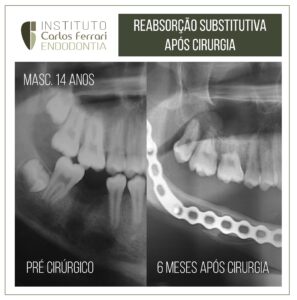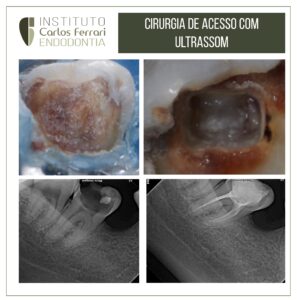Parendodontic surgery of the lower incisor with perforation.
Patient, female, 88 years old, indicated by colleague after perforation during attempt to access the lower incisor tooth for placement of intraradicular retainer. During planning, access with a guide was discarded due to the little remaining structure. We then opted for paraendodontic surgery to close the perforation and the foramen. The tooth was sealed and the canal was ready to receive treatment and retainer.
Paraendodontic surgery of the lower incisor with perforation. In: Tessare et al. Properties, Characteristics and Clinical Applications of Mineral Trioxide Aggregate - Mta. A New Perspective in Endodontics. Literature Review. Electronic Journal of Endodontics. 2005.
INTRODUCTION
After the endodontic treatment, what is expected is the repair of the treatment with the surrounding tissues as soon as possible. Accidents can happen during treatment and these in turn must also be remedied - repaired to achieve healing. One of them is the perforation that has to be "closed" to prevent airritation with the adjacent tissues, to avoid bone lesions and periodontal loss. Recently a new cement was launched in the dental market
with considerable physicochemical and biological properties in several clinical situations. Biocompatible, induces dentinogenesis, cementogenesis and osteogenesis, hydrophilic, radiopaque, with antimicrobial action and promotes adequate marginal sealing, preventing infiltration, it defines Mineral Trioxide Aggregate, better known as MTA.
Developed by Mahmoud Torabinejad, MTA is a white or gray powder that is easy to manipulate and is basically composed of mineral oxides and ions, mainly calcium and phosphate ions, which are also components of dental tissues, a fact that confers biocompatibility to the material (Torabinejad et al., 1995a; Ruiz et al., 2003). For this reason it has also been used in pulpotomies, direct pulp capping, apicifications and apicigenesis, root and furcation perforations, root fractures, retrobturations. MTA may be a new alternative for these clinical indications, as it is an excellent marginal sealer that prevents bacterial migration and penetration of tissue fluids into the root canal; it can be used in places where relative humidity is present, without loss of its properties,
unlike other materials that require an absolutely dry operative field, which is normally difficult to obtain, especially in cases of para-endodontic surgery and retrobturation.
Among these clinical indications, especially those of an endodontic nature, one of the challenges to be overcome is to develop a product that has the property to effectively treat root perforations and/or furcations with less damage to periapical tissues.
Parendodontic surgery of the lower incisor with perforation.





